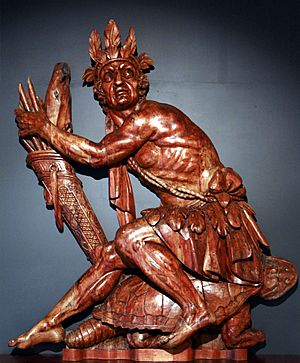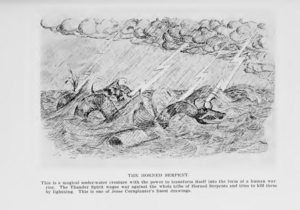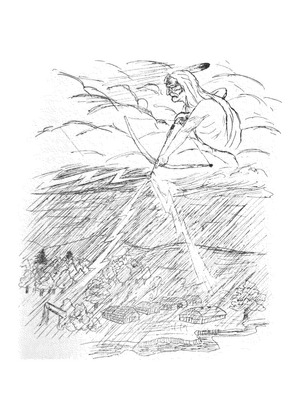Iroquois mythology facts for kids

The mythology of the Iroquois tells the creation stories and folktales of the Native American people known as the Iroquois. These people formed a group of nations, first called the Five Nations, and later the Six Nations. Long ago, these stories were kept alive by being recorded in special wampum belts and told aloud. They were only written down much later. Because of different ways of writing sounds and words, the spellings of names can be different in the written versions. Also, some stories have slightly different versions depending on where and when they were told.
Contents
Stories Passed Down
The Iroquois people have shared their stories for hundreds of years through oral traditions. These stories are more than just entertainment. They teach important lessons about values, laws, and how people should act in their communities. For example, the story "Girl Who Was Not Satisfied" teaches that you should judge people by their character, not just how they look. It also reminds people to value what they already have.
Iroquois storytelling is also a way to keep their culture alive. The stories show how the Iroquois understood the world around them. In the past, these stories were often like poems and used many metaphors. However, when they are translated into other languages, some of their original beauty can be lost. It is also possible that Christianity changed some of the written myths over time.
In 1923, a historian named Arthur C. Parker noted that it was hard to find true Iroquois folklore. He said that many writers added their own poetic ideas, which made the stories less accurate.
Each Iroquois village had a special storyteller called a Hage'ota. This person was in charge of learning and remembering all the ganondas'hag, or stories. Traditionally, stories were not told during the summer months. This was because the Iroquois believed that telling stories in summer would make animals, plants, trees, and people lazy. They thought that work would stop for a good story. If someone told stories in summer, they might get stung by a bee or choked by a snake!
Famous Iroquois Myths
Here are some examples of Iroquois myths. These were written down by people like Harriet Maxwell Converse in 1908 and Arthur C. Parker in 1923.
How the Earth Was Made
The Iroquois believe that the earth began as a thought in the mind of Hawëni:yo’. He was "He Who Governs" or "The Ruler." Hawëni:yo’ lived on a great island floating above the clouds. This island was a peaceful place where everyone had what they needed, and there was no pain or death. The people on the island held meetings under a huge apple tree.
One day, Hawëni:yo’ said, "Let's make a new place where other people can grow." He looked through a hole made by uprooting the council tree. He saw a vast sea of clouds below. He told Awëöha’i’, also called "Sky Woman," to look down. She was pregnant. Hawëni:yo’ told her to bring life to the sea below. He wrapped her in light and gently dropped her through the hole.
All the birds and animals in the cloud sea were scared. The Duck asked, "Where can she rest?" The Beaver said, "Only the oeh-dah, or 'earth,' from the bottom of our great sea can hold her." The Beaver dived down but never came back. Then the Duck tried, but its body floated to the surface. Many other animals tried and failed.
Finally, the Muskrat came back with some oeh-dah in his paws. He said, "It's heavy. Who can support it?" The Turtle offered to help. The oeh-dah was placed on his shell. The birds flew up and carried Awëöha’i’ on their wings to the Turtle's back. This is how Hah-nu-nah, the Turtle, became the one who carries the earth. When he moves, the sea gets rough, and the earth shakes.
The Twin Gods
Once the oeh-dah from the sea floor was on the Turtle's back, it grew and formed an island. Ata-en-sic (Sky Woman) went to this island, knowing it was almost time for her to give birth. She heard two voices inside her. One was calm and quiet, but the other was loud and angry. Her children were the Do-yo-da-no, or the Twin Gods. The good twin, Hah-gweh-di-yu, was born in the normal way. But the evil twin, Hä-qweh-da-ět-gǎh, forced his way out from under his mother's arm, which sadly killed her.
After Ata-en-sic died, the island became dark and gloomy. Hah-gweh-di-yu shaped the sky and made the sun from his mother's face. He said, "You will rule here where your face will shine forever." However, Hä-qweh-da-ět-gǎh created a great darkness in the west to make the sun go down. Hah-gweh-di-yu then took the moon and stars, who were his sisters, from his mother's chest. He placed them in the night sky to guard it. He gave his mother's body to the earth, which became the Great Mother from whom all life came.
Ga-gaah, the Crow, came from the sun land carrying a grain of corn in his ear. Hah-gweh-di-yu planted this corn above his mother's body, and it became the very first corn plant. Ga-gaah the Crow still flies over corn fields, protecting them and claiming his share.
With help from other spirits, Hah-gweh-di-yu created the first people. He also healed sickness, defeated bad spirits, and gave the Iroquois many special rituals. Another of his gifts was tobacco, which is very important in the Iroquois religion. On the other hand, Hä-qweh-da-ět-gǎh brought dangerous and harmful things into the world. So, the story of the Twin Gods also teaches about how people should behave and what is right and wrong.
Hé-no, the Thunder Spirit
Iroquois myths tell about Hé-no, the spirit of thunder. He brings the rain that helps crops grow. The Iroquois call Hé-no "Tisote," which means "Grandfather." He looks like a warrior and wears a magic feather on his head that makes him safe from attacks. On his back, he carries a basket filled with pieces of chert (a type of rock). He throws these at evil spirits and witches.
Hé-no lives in a cave under Niagara Falls. One time, a young girl lived above the falls. She was supposed to marry an old man she didn't like. Instead, she got into a canoe and went down the river. The canoe went over the falls and was destroyed, but the girl disappeared. Hé-no and his two helpers caught her in a blanket and took her to his cave. One of his helpers fell in love with her and married her.
Later, Hé-no saved her village from a giant serpent that was causing many diseases. He tricked the serpent into going to a spot on Buffalo Creek. There, Hé-no struck it with a thunderbolt. The serpent was badly hurt and tried to escape to Lake Erie, but it died before it could get away. Its body floated downstream to the top of Niagara Falls. It stretched almost all the way across the river and curved backward, forming a dam. The water behind the dam broke the rocks, and the snake's body fell onto the rocks below. This created Horseshoe Falls but also destroyed Hé-no's home.
De-oh-há-ko, the Three Sisters
The Iroquois name De-oh-há-ko means "Our Life" or "Our Supporters." These are often called the Three Sisters, and they are the spirits of corn, beans, and squash. The sisters appear as beautiful young women. They love each other and like to live close together. This is like how the three plants are traditionally grown together in the same mound of earth.
One day, O-na-tah, the spirit of the corn, was walking alone. She was captured by Hä-qweh-da-ět-gǎh, the evil Twin God. Hä-qweh-da-ět-gǎh sent one of his monsters to destroy the fields, and the other sisters ran away. Hä-qweh-da-ět-gǎh held O-na-tah captive in darkness under the earth. She was trapped until a ray of sunlight reached the surface and found her. Once she was back on earth, she cried over her destroyed fields and how her sisters had left her. She promised never to leave her fields again and now guards them alone.
Jo-ga-oh, the Little People
Iroquois myths also tell about the dzögä́:ö’, or Jo-gä-oh, known as the Little People. The dzögä́:ö’ are invisible nature spirits, much like the fairies in European stories. They protect and guide the natural world and keep people safe from unseen enemies. There are three tribes of dzögä́:ö’.
The first tribe is the Ga-hon-ga. They live in rivers and rocks, often in rocky caves beside streams. They are very strong, even though they are small. The Ga-hon-ga love showing off their strength and often invite people to their homes for contests. They enjoy playing ball with rocks, throwing them high into the air. Because of this, they are often called Stone Throwers.
The second tribe is the Gan-da-yah. They protect and guide fruits and grains. Throughout the growing season, the Gan-da-yah guard crops from sickness and pests. Their special gift is the strawberry plant. In the spring, they loosen the earth so strawberries can grow. They turn the strawberry leaves toward the sun and guide their runners. When the strawberries are ripe, the Honödí:ön (Company of Faith Keepers) hold a spring festival. This includes nighttime dances to thank the dzögä́:ö’. These spirits sometimes visit people as a robin for good news, an owl for a warning, or a bat for a serious life-or-death situation. People who believe in the Gan-da-yah say that even the smallest insect might carry an important message from the "Little People."
The third tribe of dzögä́:ö’ are the Oh-do-was. They live in the shadowy places under the earth. In this underworld, there are forests and animals, including a white buffalo. The Oh-do-was guard against poisonous snakes and creatures of death that try to escape from the underworld. Sometimes, the Oh-do-was come out at night and visit the world above. They hold festivals and dance in rings around trees. After they dance, grass will not grow in the ring.
Gǎ-oh, the Wind Spirit
Iroquois myths also tell about Gaoh, who is the spirit of the wind. He is a giant and is like a tool through whom the Great Spirit controls the weather. His home is in the far northern sky. He controls the four winds: the north wind (Bear), the west wind (Panther), the east wind (Moose), and the south wind (Fawn).
The North Wind is a bear spirit named Ya-o-gah. Ya-o-gah could destroy the world with his very cold breath, but Gǎ-oh keeps him in check. Ne-o-ga, the south wind, is "gentle and kind as a sunbeam." The West Wind, the panther Da-jo-ji, "can climb high mountains and tear down forests...carry whirlwinds on [his] back, and toss great sea waves high in the air." O-yan-do-ne, the east wind, blows his breath "to chill the young clouds as they float through the sky."
So-son-do-wah, the Hunter
According to Iroquois mythology, So-son-do-wah is a great hunter. He is known for tracking a special elk. He was captured by Dawn, a goddess who needed him as a watchman. So-son-do-wah fell in love with a human woman named Gendenwitha (meaning "She Who Brings the Day"). He tried to win her over with songs. In spring, he sings as a bluebird. In summer, he sings as a blackbird. In autumn, he sings as a hawk. The hawk tried to take Gendenwitha into the sky with him. However, Dawn tied So-son-do-wah to her doorpost. She then changed Gendenwitha into the Morning Star. This way, the hunter can watch her all night but can never be with her.
The Flying Head
Iroquois mythology also tells of the Flying Head (Mohawk: Kanontsistóntie). This is a monster that looks like a giant head without a body, as tall as a man. It is covered with thick hair and has long black wings and sharp claws. At night, the Flying Head comes to the homes of widows and orphans. It beats its wings on the walls and makes scary cries in a strange language. A few days after the Flying Head visits, someone in the family dies. The Seneca name for the Flying Head is Takwánö'ë:yët, which means "whirlwind."
Djodi'kwado, the Horned Serpent

According to Iroquois mythology, Djodi'kwado' is a horned serpent. He lives deep in rivers and lakes. He can even change into the form of a man. He appears in stories like "Thunder Destroys Horned Snake" and "The Horned Serpent Runs Away with a Young Wife who is Rescued by the Thunderer." In some tales, he seems helpful, but his help is not always useful. Hé-no, the thunder spirit, attacked and may have killed Djodi'kwado'.
The Three Brothers
This is an Iroquois sun myth about three brothers. They grew tired of being on earth and decided to chase the sun into the sky. Two of the brothers made it, and the third succeeded in spirit only. The Sun Spirit changed and tested the two brothers. They stayed in the sky for many years. Eventually, they missed their home and returned. But they found that many years had passed, and everything they knew had changed or was gone. They longed to return to the sky. They finally went back to the sky when they were struck by lightning, as dangers on earth could not harm them.
See also


